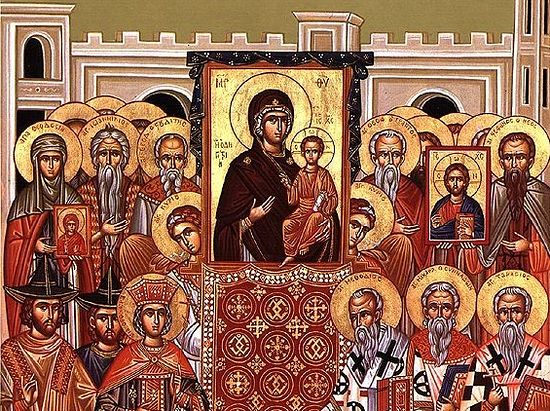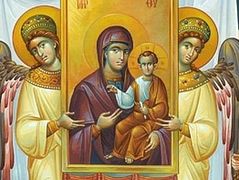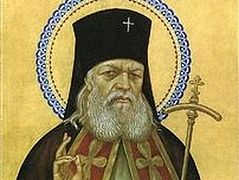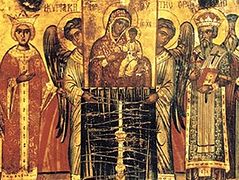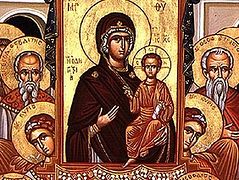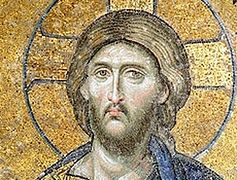I rejoice when I see the veneration due the icons once so ignominiously rejected
On this first Sunday of Great Lent, the Sunday of Orthodoxy, the Church of Christ celebrates the restoration of the holy and venerable icons by the Emperor Michael, the holy and blessed Empress Theodora and the Holy Methodius, Patriarch of Constantinople.
Through God’s indulgence Leo the Isaurian, a swineherd and keeper of donkeys, inherited the scepter of the kingdom. At that time Saint Germanus was at the helm of the Church. Leo sent for him and said, "Since it seems to me that there is no difference between the holy icons and idols, command that they be removed immediately from among us. Although if they are true likenesses of the saints, let them be hung higher on the walls so that we who are wallowing in sins do not defile them by venerating them." But the Patriarch responded thus to the Emperor’s abomination, "O King, we have heard of someone who once raised his hand against the holy icons. He was called Conon. Could you be this man?" The emperor said, "I was so called as a child." And since the Patriarch refused to obey the emperor, he deposed him and installed Anastasius, who sympathized with him. And so at that time began the struggle against the holy icons.
After this Leo Constantine Copronymus became heir to the kingdom as well as to the savage attacks against the holy icons. And what can be said about the number and kind of deeds that lawless man committed except that he came to a most shameful end. His son, whose mother was a Khazar, inherited the kingdom after him, and he also came to a bad end. Irene and Constantine then ascended the throne. At the direction of the holy Patriarch Tarasius they assembled the Seventh Council, and the holy icons were once more accepted by Christ’s Church. After they relinquished the kingdom, Nicephorus ascended to the throne. After him there were Stauracius and then Michael Rhangabe, who were both iconodules.
The beast-like Leo the Armenian seized the throne from Michael, and, having been misled by an impious hermit, began the second iconoclasm. And once more the Church was bereft of Her beauty. Michael Amorius succeeded him, whose son Theophilus then for the second time directed this madness against the icons. For it was this Theophilus who gave many of the Holy Fathers over to torments and tortures, seeking the truth about the holy icons and believing whatever he would. "If there be anyone in the city intent on uprising, then he will be caught not long after I am told." And after reigning for 12 years, he was stricken with an intestinal disorder so that he desired to relinquish his life. His mouth opened so wide, that his internal organs were visible.
The empress was so upset at what had happened, that she could barely sleep. And in a dream she beheld the most pure Theotokos holding the pre-eternal Child, surrounded by most luminous angels. They were striking Theophilus her husband and humiliating him. Now when her dream had passed and Theophilus had come to his senses, he cried, "Woe is me in my wretchedness, I am struck for the sake of the holy icons." And immediately the empress held an icon of the Theotokos above him and entreated her with tears. And Theophilus, so inclined, saw that one of the clergy surrounding him had an engolpion, which he grabbed and kissed. Now as soon as his lips touched the icon, and he opened wide his mouth, he returned to normal and was relived of the adversity and affliction and fell asleep, after confessing that it is good to venerate the holy icons. Then the empress, fetching the holy and precious images from her bedchamber, convinced Theophilus to kiss them and venerate them with all his heart. A short while afterwards Theophilus departed this life. Theodora then commanded that all who were in exile and in prison be freed. John was deposed from the patriarchal throne, since he was more a sorcerer and demon worshiper than patriarch. Then Methodius, a confessor of Christ, ascended the throne, having suffered much through having been closed up in a tomb alive.
While he was there, Ioannicius the Great, who was practicing asceticism on Mount Olympus, received a divine visitation. The great faster Arsaacius came to him and said, "God has sent me to you, that we might go to the righteous Isaiah the recluse in Nicomedia and learn from him what God desires and what is fitting for His Church." Now when they came to the venerable Isaiah, he said to them, "Thus saith the Lord: Behold, the end is approaching for the enemies of My image. Go to the empress Theodora and to the Patriarch Methodius and tell them: ‘Cease to do what is not holy, and offer sacrifice to Me with the angels by venerating the countenance of My image and of the Cross’." Hearing this they immediately left for Constantinople and announced what had been said to Patriarch Methodius and all God’s assembled people. The assembly then went to the empress and found her agreeable in all things, since this was the pious and God-loving tradition of the Fathers. The empress straightway brought out the image of the Theotokos for all to see, and venerating it, she said, "Let all be condemned who do not venerate the images, kissing them in love, not in worship as gods, but as images for the sake of the love of their archetypes. And they rejoiced with great joy. And in response she entreated them to pray for her husband Theophilus. Seeing her faith, they obeyed reluctantly. For Patriarch Methodius among the saints assembled all the people, priests and bishops and proceeded to God’s Great Church. Among the assembled were Joannicius the Great from Olympus, Arsaacius, Pancratius and the disciples of Theodore the Studite, and confessors Theophanes and Theodore Graptoi, Michael of the Holy City and Singelus and many others. And they prayed to God for Theophilus in tears all night long.
Now this took place throughout the first week of the Great Fast, with the empress Theodora herself, the women and all the people taking part. Having completed the prayers, the empress Theodora retired at dawn on Friday, and dreamed that she was at the foot of the Cross, and there were several people passing noisily by, wearing various instruments of torture. As she recognized the Emperor Theophilus among those being led with his hands bound behind his back, she followed the group and its guards. When they reached the brass gates, she saw a supernatural vision, a man sitting in front of the image of Christ and Theophilus brought before him. Reaching to touch his feet, the empress prayed for the emperor. He opened his mouth and said, "Great is thy faith, O woman. Know that because of thy tears and thy faith, as well as the prayers and petitions of My servants and My priests, I grant forgiveness to thy husband Theophilus." Then He said to the guards, "Loose him and give him to his wife." And taking him, she departed rejoicing in gladness. And immediately the dream left her.
Now Patriarch Methodius, while the prayers and petitions were being offered for him, had taken a new parchment scroll and written the names of all the heretical emperors, including Theophilus, placing it under the holy altar table. But on Friday he saw a great and terrible angel entering the temple, coming to him and saying, "Thy petition has been heard, O Bishop, and the Emperor Theophilus has received forgiveness. Trouble the Godhead about this no longer." And desiring to ascertain the truth of his vision the Patriarch descended from his place, and taking the parchment and unrolling it, he found (O, the judgments of God!) that all reference to the name of Theophilus has been erased by God.
Upon hearing this, the empress rejoiced greatly and requested the Patriarch to assemble all the people with the holy icons and crosses in the great church, so that might be adorned with the holy icons and God’s new miracle could be known by all. And soon when all had gathered in the church holding candles, the empress arrived with her son. And a Litiya was served there with the holy icons and the divine and precious wood of the Cross and with the sacred and divine Gospels. And leaving the church, calling out, "Lord, have mercy," they processed the agreed mile. Then they returned to the church, where Divine Liturgy was celebrated.
When the holy and precious icons were returned to their place, the holy men mentioned earlier and the pious Orthodox rulers were glorified, and those impious people who did not accept the honor of the holy icons were anathematized and condemned. And from that time these holy confessors appointed the annual commemoration of this solemnity, so that we might never again fall into a similar ignominy.
O unchanging Image of the Father, through the prayers of Thy holy confessors, have mercy on us. Amen.
Translated from Triodion, siest' Tripesnets: Triod' Postnaya, Moscow, 1904, by Robert Parent.

